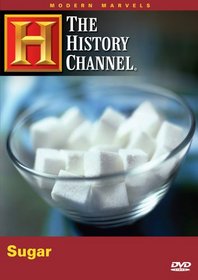| Genres: Documentary Sub-Genres: Documentary Studio: A&E Home Video Format: DVD DVD Release Date: 06/27/2006 Release Year: 2006 Run Time: 0hr 50min Number of Discs: 1 SwapaDVD Credits: 1 Total Copies: 0 Members Wishing: 4 MPAA Rating: Unrated Languages: English |
Search - Modern Marvels - Sugar (History Channel) on DVD
  | Modern Marvels - Sugar History Channel Genres: Documentary UR 2006 0hr 50min The sugar industry came of age on the backs of slaves toiling in Caribbean fields, and British desire to control production of sugar and its byproduct, rum. Sugar also played a surprisingly critical part in America's battl... more » |
Larger Image |
Movie DetailsSimilar Movies
|
Movie ReviewsYum! Sugar! Jeffery Mingo | Homewood, IL USA | 05/23/2007 (4 out of 5 stars) "We benefit when we learn about the things we take as a given. This made me think deeply about the sugar I use frequently and to which I don't pay much attention. I wondered how sugar could be discussed under a series called "MODERN Marvels" (my emphasis). The program pays especial attention to the engineering and chemistry behind sugar production. That's good for business and science types. As a social science person, I was more interested in the history of sugar and this program provides info on that as well. The program is very inclusive. It speaks for sugar's byproducts (molasses and rum) as well as the competition for sugar. The interviewees are male and female; white and of color; from the developed world and the developing world. By showing both CEOs and factory workers, it tries to have a diverse, economic class presentation as well. One Brazilian interviewee had large, thick eyebrows; one Californian scholar looked like actor Christopher Walken. In discussing using sugar, rather than gas, in cars, I worried the program wouldn't talk about an environmental impact. Luckily it does. In talking about sugar production in the Caribbean, I worried that it would gloss over that sugar was harvested on the backs of African slaves. It isn't afraid to touch upon that tragedy. The work only mentions obesity in one sentence at the end. It never mentions the command, "Get the molasses out of your gluteus maximus." It doesn't reminisce about the time that Homer Simpson tried to sell sugar he found. I'm a fatty, but this didn't make me want to buy sugar like the episode on candy made me hungry." Interesting and Educational! Loyd E. Eskildson | Phoenix, AZ. | 10/29/2008 (5 out of 5 stars) "The average American consumes 43 lbs. of sugar each year, more than the Chinese, less than those in Australia. (We also consume 65 lbs. of high fructose corn syrup each year.)
Sugar cane is a tropical grass grown by planting clones, not seeds. Crops in Hawaii take two years to mature, reaching 30 feet in height and yielding 120 tons/acre. (Ten lbs. of stalk creates 1-1.5 lbs. sugar.) Stalks are first cleaned, then chopped into fine pieces, crushed, boiled and concentrated five times, spun in centrifuges (molasses is a by-product). California grows sugar beets - these are ready one year after planting. Machines dig under the roots and bring the 3-4 lb. beets up to the surface. Processing is similar to that of cane sugar. Additional sugar is taken from the molasses by a process introduced in 1995 and increasing overall sugar yield 25%. Westerners discovered sugar as a result of the Crusades. Columbus brought sugar to the New World. There it accidentally led to the discovery of rum and the two products together created a demand for slaves. According to "Sugar," one of the reasons Britain withdrew from America was to concentrate on battling France for the West Indies and its sugar. Raw sugar is brown (contains molasses), confectioners sugar is pure sugar ground into powder. Sugar now is being used in cosmetics, as well as making cereal crisp, a source for rum, and an ingredient in ice cream, preservative in jam, and in countless foods and soft drinks outside the U.S. High fructose corn syrup is used in American soft drinks because it is cheaper. Brazil is now growing extensive sugar cane as a source of ethanol - costs half as much as gasoline. The fibrous residue from sugar cane is used to generate power at sugar plants in Hawaii, as well as 7% of Maui's electricity. Scientists now are experimenting with inserting DNA into sugar cane to grow human protein without the risk of host viruses crossing over." |




